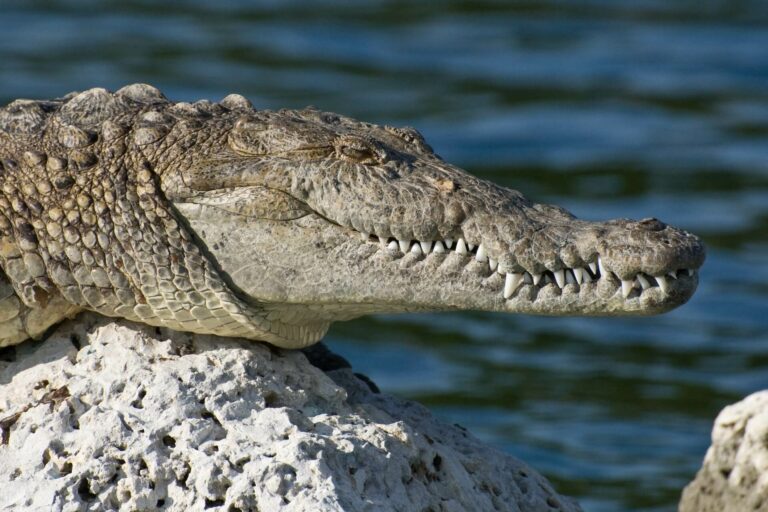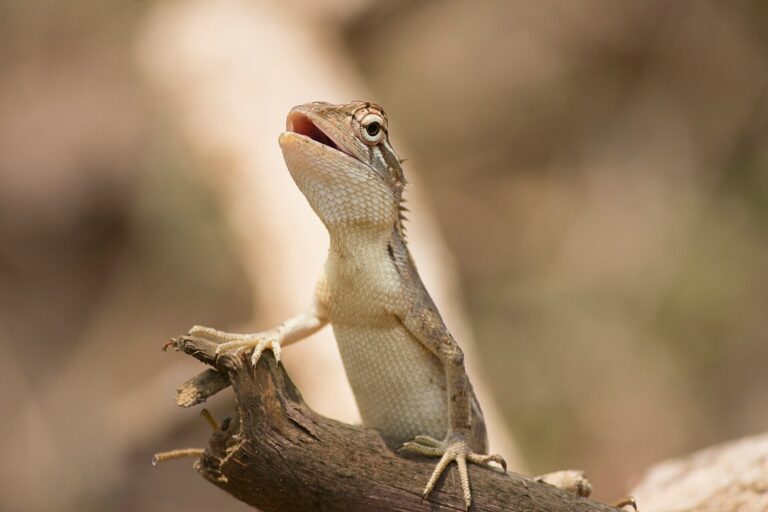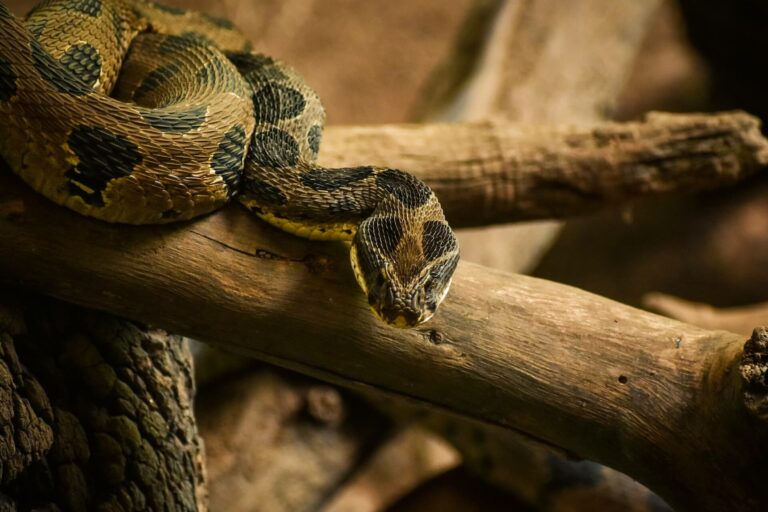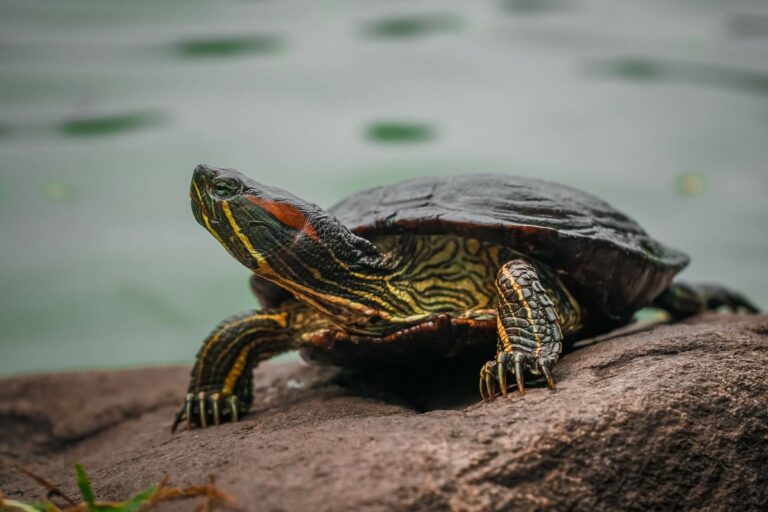MORPHOLOGY: REPTILES
CROCODILES
Platt S. G., Brantley C. G., Cropanzano R. S., Hastings R. W. (1990): A method for determining the size of nesting female alligators. Wildlife Society Bulletin 18: 296-298.
FULL TEXT
Excerpt
We report on a method to estimate the snout-vent length (SVL) of nesting female alligators using rear-foot track measurements. This method was used by us during a study of the American alligator on the Manchac Wildlife Management Area in St. John the Baptist Par- ish, Louisiana (30018’N, 90020’W).
Macip-Ríos R., Fernández-Aguilar M., Barrios-Quiroz G., Casas-Andreu G. (2012): Indirect morphological measures to infer body size in a wild population of the Chiapas Spectacled Caiman, Caiman crocodilus chiapasius (Bocourt, 1876). Herpetological Conservation and Biology 7: 367-375.
FULL TEXT
Abstract
Several indirect measures (photographs, tracks, skulls) and remote techniques (nocturnal spotlight surveys) have been suggested as ways to estimate body size in crocodilians; however, the analysis of this kind of data does not fit the basic assumptions of the statistical allometric approach. We tested the utility of these techniques to infer body size from head and left foot measurements from a wild population of a subspecies of the Spectacled Caiman (Caiman crocodilus chiapasius) in Chiapas, Mexico using an allometric approach. We also tested for sexual size dimorphism using total length and snout-vent length. We only found sexual size dimorphism in total length. We also found that the snout length, inter-orbital width, and foot length have an isometric correlation with body size (total length or snout-vent length). Snout length and foot length measurements explained 65 to 74% of the body size variance when we analyzed overall data or only data from males, and seem to be useful to infer body size in this species. We suggest a conservative and speciesspecific use of indirect or remote measurements to estimate body size in crocodiles.
Platt S. G., Elsey R. M., Bishop N. D., Rainwater T. R., Thongsavath O., Labarre D., McWilliam A. G. (2020): Using scat to estimate body size in crocodilians: Case studies of the Siamese crocodile and American alligator with practical applications. Herpetological Conservation and Biology 15: 325-334.
FULL TEXT
Abstract
Models relating morphological measures to body size are of great value in crocodilian research and management. Although scat morphometrics are widely used for estimating the body size of large mammals, these relationships have not been determined for any crocodilian. To this end, we collected scats from Siamese Crocodiles (Crocodylus siamensis) and American Alligators (Alligator mississippiensis) to determine if maximum scat diameter (MSD) could be used to predict total length (TL) in these species. We obtained scats from 19 and 22 C. siamensis and A. mississippiensis, respectively, and evaluated the relationship between MSD and TL using logarithmic regression models. We found significant positive relationships between MSD and TL for both species. We attribute this relationship to anatomical constraints imposed on MSD by pelvic aperture width, which in turn correlates to body size. We found the MSD-TL relationship is similar for C. siamensis and A. mississippiensis. Our models can be used to increase precision of body size estimates in scat-based population surveys and dietary studies, and estimate the body size of nesting females.
Aubert C., Le Moguédec G., Velasco A., Combrink X., Lang J. W., Griffith P., Pacheco-Sierra G., Pérez E., Charruau P., Villamarín F., Roberto I. J. (2024): Estimating total length of partially submerged crocodylians from drone imagery. Drones 8: 115.
FULL TEXT
Abstract
Understanding the demographic structure is vital for wildlife research and conservation. For crocodylians, accurately estimating total length and demographic class usually necessitates close observation or capture, often of partially immersed individuals, leading to potential imprecision and risk. Drone technology offers a bias-free, safer alternative for classification. We evaluated the effectiveness of drone photos combined with head length allometric relationships to estimate total length, and propose a standardized method for drone-based crocodylian demographic classification. We evaluated error sources related to drone flight parameters using standardized targets. An allometric framework correlating head to total length for 17 crocodylian species was developed, incorporating confidence intervals to account for imprecision sources (e.g., allometric accuracy, head inclination, observer bias, terrain variability). This method was applied to wild crocodylians through drone photography. Target measurements from drone imagery, across various resolutions and sizes, were consistent with their actual dimensions. Terrain effects were less impactful than Ground-Sample Distance (GSD) errors from photogrammetric software. The allometric framework predicted lengths within ≃11–18% accuracy across species, with natural allometric variation among individuals explaining much of this range. Compared to traditional methods that can be subjective and risky, our drone-based approach is objective, efficient, fast, cheap, non-invasive, and safe. Nonetheless, further refinements are needed to extend survey times and better include smaller size classes.
LIZARDS
Lambert M. R., Yasuda C. M., Todd B. D. (2012): Evaluation of a photographic technique for estimating body size in lizards from a distance. Herpetological Conservation and Biology 7: 83-8.
FULL TEXT
Abstract
Body size is often an important factor in understanding an animal’s ecology. In squamates, snout-to-vent length (SVL) is a primary metric for quantifying body size. Measuring SVL typically requires capture and handling of animals, which may be difficult due to a species’ behavior or its presence in complex habitat. Here, we evaluated an alternative to the capture, handling, and direct measurement of lizards via the use of paired photographs of animals in situ and with a ruler positioned in place of the lizard. Paired digital images were processed using the freely available image analysis software ImageJ. We found that snout-to-hindlimb length (SHL) measured directly on an animal was highly correlated with its SVL. In turn, SHL estimated from images was highly correlated with SHL measured directly on the animals and had an average error of 19.4 ± 16.2% (1 SD) compared with measurements made on the animals themselves. Estimates of total length from images were also highly correlated with total length measurements made directly on the animals and had an average error of 14.8 ± 12.9% (1 SD). There was no correlation between image measurement error and the distance from which photographs were made. Our results identify that the use of digital photographs and image analyses can in some cases eliminate the need to capture and handle lizards to quantify body size.
Broeckhoven C., Du Plessis A., le Roux S. G., Mouton P. L. F. N., Hui C. (2017): Beauty is more than skin deep: a non‐invasive protocol for in vivo anatomical study using micro‐CT. Methods in Ecology and Evolution 8: 358-369.
FULL TEXT
Abstract
Microcomputed tomography (μCT) is a widely used tool in biomedical research, employed to investigate tissues and bone structures of small mammals in vivo. The application of in vivo μCT scanning in non-medical studies greatly lags behind the rapid advancements made in the biomedical field wherein the methodology has evolved to allow for longitudinal studies and eliminate the need to sacrifice the animal. Ecological and evolutionary studies often involve morphological measurements of a large sample of live animals; however, the potential of in vivo μCT imaging as a method for data acquisition has yet to be delineated. Here, we describe a protocol for in vivo μCT imaging of the internal anatomy of reptiles and amphibians, commonly used study organisms in ecological and evolutionary research. We consider the skeletal and extraskeletal (i.e. osteoderms) bones of a lizard as a case study to elucidate the potential of in vivo μCT imaging. First, we explore the effects of various parameter settings on radiation dose, scan time and image quality. Secondly, we develop a protocol to immobilize and restrain study organisms during scanning without need for the administration of anaesthetics and compare the results of the in vivo protocol to images obtained post-mortem. To immobilize animals, we replace the use of anaesthetics by cooling, thereby allowing the use of previously unsuitable rotating gantry μCT scanners that are readily available in scientific institutions. The resultant image quality of in vivo μCT scans is similar to that of post-mortem μCT scans, especially in the abdominal region. We discuss the effect of tube voltage, distance to X-ray source and metal filtration on radiation dose, and how these parameters could be altered to reduce the cumulative radiation dose while maintaining optimal image quality. The proposed in vivo μCT protocol offers a new approach to acquire anatomical information for non-biomedical studies. We offer specific suggestions as to how the protocol can be employed to suit a variety of model organisms.
Summers T. C., Ord T. J. (2022): Signal detection shapes ornament allometry in functionally convergent Caribbean Anolis and Southeast Asian Draco lizards. Journal of Evolutionary Biology 35: 1508-1523.
FULL TEXT
Abstract
Visual ornaments have long been assumed to evolve hyper-allometry as an outcome of sexual selection. Yet growing evidence suggests many sexually selected morphologies can exhibit other scaling patterns with body size, including hypo-allometry. The large conspicuous throat fan, or dewlap, of arboreal Caribbean Anolis lizards was one ornament previously thought to conform to the classical expectation of hyper-allometry. We re-evaluated this classic example alongside a second arboreal group of lizards that has also independently evolved a functionally equivalent dewlap, the Southeast Asian Draco lizards. Across multiple closely related species in both genera, the Anolis and Draco dewlaps were either isometric or had hypo-allometric scaling patterns. In the case of the Anolis dewlap, variation in dewlap allometry was predicted by the distance of conspecifics and the light environment in which the dewlap was typically viewed. Signal efficacy, therefore, appears to have driven the evolution of hypo-allometry in what was originally thought to be a sexually selected ornament with hyper-allometry. Our findings suggest that other elaborate morphological structures used in social communication might similarly exhibit isometric or hypo-allometric scaling patterns because of environmental constraints on signal detection.
SNAKES
Siers S. R. (2021): Allometric regression of snake body length from head image measurements. Wildlife Society Bulletin 45: 538-545.
FULL TEXT
Abstract
As in many fields of wildlife research and management, camera devices and photogrammetry have become an integral part of the toolkit for exploring otherwise-unseen aspects of the biology, behavior, and control of the invasive brown treesnake (Boiga irregularis) on Guam. Because brown treesnakes are cryptic and nocturnal, and nearly all aspects of their ecology are influenced by snake size, methods are needed to estimate snake size from images captured by infrared wildlife cameras. Unfortunately, it is difficult to capture images of an entire snake’s length at a controlled distance from a simple camera setup. Here, I describe the allometric relationships between brown treesnake body length and potential predictors: head measurements, sex, and body condition. Head length (HL) was the most important predictor of body length, alone accounting for 95.9% of the variation in brown treesnake snout-vent length (SVL). We provide simple regression equations for predicting brown treesnake length from head measurements, an example of how to extract measurements from images, and a convenient lookup table for predicting SVL and 80% prediction intervals from HL alone. Coupled with a simple camera setup that controls subject distance and includes size standards in the image, we can estimate brown treesnake body size from images that include only the head when photographed from above. These methods have been developed to enable ongoing assessments of brown treesnake predation risk following landscape-scale suppression efforts that could enable the reintroduction of extirpated native wildlife.
TURTLES
Valenzuela N., Adams D. C., Bowden R. M., Gauger A. C. (2004): Geometric morphometric sex estimation for hatchling turtles: a powerful alternative for detecting subtle sexual shape dimorphism. Copeia 2004: 735-742.
FULL TEXT
Abstract
Identifying sex of hatchling turtles is difficult because juveniles are not obviously externally dimorphic, and current techniques to identify sex are often logistically unfeasible for field studies. We demonstrate a widely applicable and inexpensive alternative to detect subtle but significant sexual dimorphism in hatchlings, using landmark-based geometric morphometric methods. With this approach, carapace landmarks were digitized from photographs of each hatchling, and shape variables were generated after variation in size, location and orientation were eliminated. These variables were then analyzed for sexual dimorphism, and used in discriminant function analysis to estimate sex of each hatchling. Using this approach on two species (Chrysemys picta and Podocnemis expansa), we found this method had high accuracy in assigning sex when compared with true sex (98% and 90%, respectively), and cross-validation revealed a correct classification rate of 85%. These correct classification rates were considerably higher than those found on the same species using linear distance measurements as data. We also explored two alternative statistical approaches for assessing sex (K-means clustering and multiple logistic regression) and found that these alternative approaches were accurate only 61% and 78% of the time, respectively, in C. picta and 69% and 77% of the time in P. expansa. These findings are similar to classification rates found for turtle species using approaches based on linear distance measurements. We also found that the observed sexual dimorphism differed between the two species. In P. expansa, males displayed relatively more expansion of the central region of the carapace relative to females, whereas in C. picta this pattern was reversed. We conclude that discriminant analysis of morphology quantified using geometric morphometrics provides researchers with a powerful tool to discriminate between male and female hatchling turtles.
Siegfried T. R., Fuentes M. M., Ware M., Robinson N. J., Roberto E., Piacenza J. R., Piacenza S. E. (2021): Validating the use of stereo‐video cameras to conduct remote measurements of sea turtles. Ecology and Evolution 11: 8226-8237.
FULL TEXT
Abstract
Stereo-video camera systems (SVCSs) are a promising tool to remotely measure body size of wild animals without the need for animal handling. Here, we assessed the accuracy of SVCSs for measuring straight carapace length (SCL) of sea turtles. To achieve this, we hand captured and measured 63 juvenile, subadult, and adult sea turtles across three species: greens, Chelonia mydas (n = 52); loggerheads, Caretta caretta (n = 8); and Kemp’s ridley, Lepidochelys kempii (n = 3) in the waters off Eleuthera, The Bahamas and Crystal River, Florida, USA, between May and November 2019. Upon release, we filmed these individuals with the SVCS. We performed photogrammetric analysis to extract stereo SCL measurements (eSCL), which were then compared to the (manual) capture measurements (mSCL). mSCL ranged from 25.9 to 89.2 cm, while eSCL ranged from 24.7 to 91.4 cm. Mean percent bias of eSCL ranged from −0.61% (±0.11 SE) to −4.46% (±0.31 SE) across all species and locations. We statistically analyzed potential drivers of measurement error, including distance of the turtle to the SVCS, turtle angle, image quality, turtle size, capture location, and species. Using a linear mixed effects model, we found that the distance between the turtle and the SVCS was the primary factor influencing measurement error. Our research suggests that stereo-video technology enables high-quality measurements of sea turtle body size collected in situ without the need for hand-capturing individuals. This study contributes to the growing knowledge base that SVCS are accurate for body size measurements independent of taxonomic clade.
Piacenza S. E., Piacenza J. R., Faller K. J., Robinson N. J., Siegfried T. R. (2022): Design and fabrication of a stereo-video camera equipped unoccupied aerial vehicle for measuring sea turtles, sharks, and other marine fauna. Plos One 17: e0276382.
FULL TEXT
Abstract
The recent commercialization of unoccupied aerial vehicles (UAVs) has facilitated their incorporation into a variety of ecological studies. While UAVs are able to provide accurate visual data of marine species from an aerial perspective, these devices have some limitations that make measuring marine animals below the surface challenging. Many marine organisms are often visible from the air, but are deeper in the water column, and current methods cannot measure animals below the surface. Here, we developed and tested a stereo-video camera (SVC) system that was mounted onto a commercially-available UAV. We used the SVC-UAV to conduct remote body-size measurements for two marine species: the green sea turtle (Chelonia mydas) and the nurse shark (Ginglymostoma cirratum). When comparing SVC measurements to those taken by hand, the SVC-UAV had a mean absolute error (MAE) of 4.44 cm (n = 6; mean percent error (MPE) = 10.6%) for green sea turtles and 7.16 cm absolute error (n = 1; PE = 3.6%) for the nurse shark. Using a linear model, we estimated the slope of the SVC versus hand measurements for green sea turtles to be 1.085 (±0.099 SE), and accounting for the standard error, a measurement bias was not apparent. Using model selection, based on a global model predicting MAE from animal distance to the SVC and body size, the top ranked model was the intercept-only model. This indicates that neither animal distance nor body size strongly influenced measurement error. Incorporating SVC systems into UAVs can allow for relatively accurate measurements of near surface-dwelling marine species. To our knowledge, there is no other stand-alone SVC for UAVs available that offers similar accuracy and utility.
Siegfried T. R., Reimer J., Roberto E., Noren C., Vidal A., Dixon K., DuBois M., Piacenza S. E. (2022): Size-mediated sea turtle behavioral responses at artificial habitats in the northern Gulf of Mexico. Animals 13: 114.
FULL TEXT
Abstract
Our understanding of size-specific sea turtle behavior has lagged due to methodological limitations. However, stereo-video cameras (SVC) are an in-water approach that can link body-size and allow for relatively undisturbed behavioral observations. In this study, we conducted SVC dive surveys at local artificial reefs, piers, and jetties in the northern Gulf of Mexico (nGOM) from May 2019 to August 2021. Using SVCs, we measured sea turtle straight carapace length, documented behaviors, and quantified wariness by assessing minimum approach distance (MAD). In green sea turtles (Chelonia mydas), the observed MAD ranged from 0.72 to 5.99 m (mean 2.10 m ± 1.10 standard deviation (SD), n = 73). For loggerhead sea turtles (Caretta caretta), the MAD ranged between 0.93 and 3.80 m (mean 2.12 m ± 0.99 SD, n = 16). Kemp’s ridley sea turtles (Lepidochelys kempii) were similar to loggerheads, and MAD ranged from 0.78 to 3.63 m (mean 2.35 m ± 0.99 SD, n = 8). We then evaluated what biological factors could impact the MAD observed by species, but we excluded Kemp’s ridleys as the sample size was small. Using a linear mixed model and model selection based on AICc, the top ranked model for both green and loggerhead sea turtles included SCL as the most important factor influencing MAD. MAD did not vary with habitat type for either species. Our results showed that larger individuals, regardless of species, have a greater wariness response, becoming startled at greater distances than smaller individuals. The findings of our study support the use of SVC as an accessible, non-invasive tool to conduct ecologically relevant in-water surveys of sea turtles to link behavioral observations to body size.
Panda A. K., Verma V., Srivastav A., Badola R., Hussain S. A. (2024): Digital image processing: A new tool for morphological measurements of freshwater turtles under rehabilitation. Plos One 19: e0300253.
FULL TEXT
Abstract
Freshwater fauna is facing an uphill task for survival in the Ganga Basin, India, due to a range of factors causing habitat degradation and fragmentation, necessitating conservation interventions. As part of the ongoing efforts to conserve the freshwater fauna of the Basin, we are working on rehabilitating rescued freshwater chelonians. We carry out various interventions to restore rescued individuals to an apparent state of fitness for their release in suitable natural habitats. Morphometric measurements are crucial to managing captive wild animals for assessing their growth and well-being. Measurements are made using manual methods like vernier caliper that are prone to observer error experience and require handling the specimens for extended periods. Digital imaging technology is rapidly progressing at a fast pace and with the advancement of technology. We acquired images of turtles using smartphones along with manual morphometric measurements using vernier calipers of the straight carapace length and straight carapace width. The images were subsequently processed using ImageJ, a freeware and compared with manual morphometric measurements. A significant decrease in the time spent in carrying out morphometric measurements was observed in our study. The difference in error in measurements was, however, not significant. A probable cause for this may have been the extensive experience of the personnel carrying out the measurements using vernier caliper. Digital image processing technology can cause a significant reduction in the stress of the animals exposed to handling during measurements, thereby improving their welfare. Additionally, this can be used in the field to carry out morphometric measurements of free-ranging individuals, where it is often difficult to capture individuals, and challenges are faced in obtaining permission to capture specimens.





